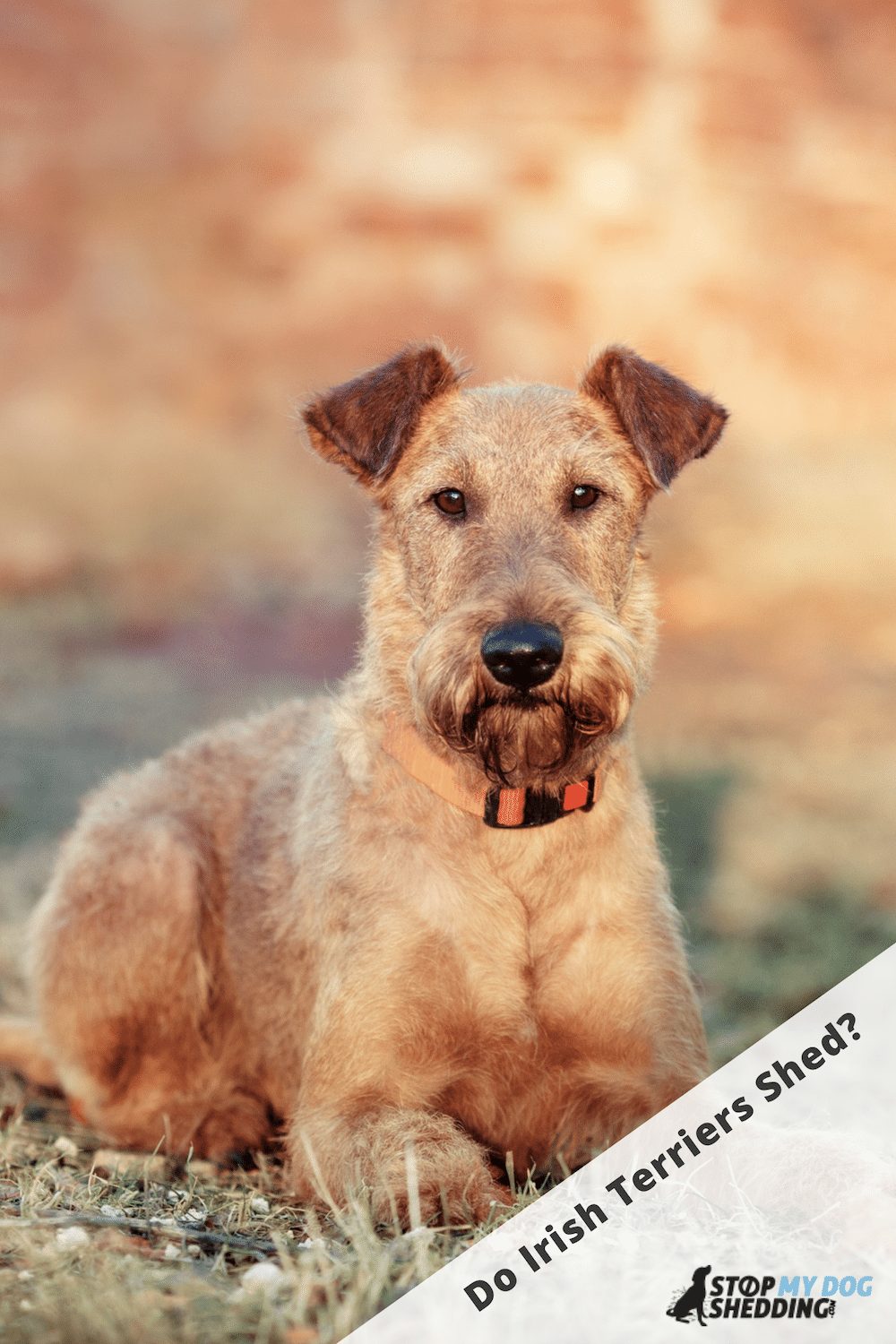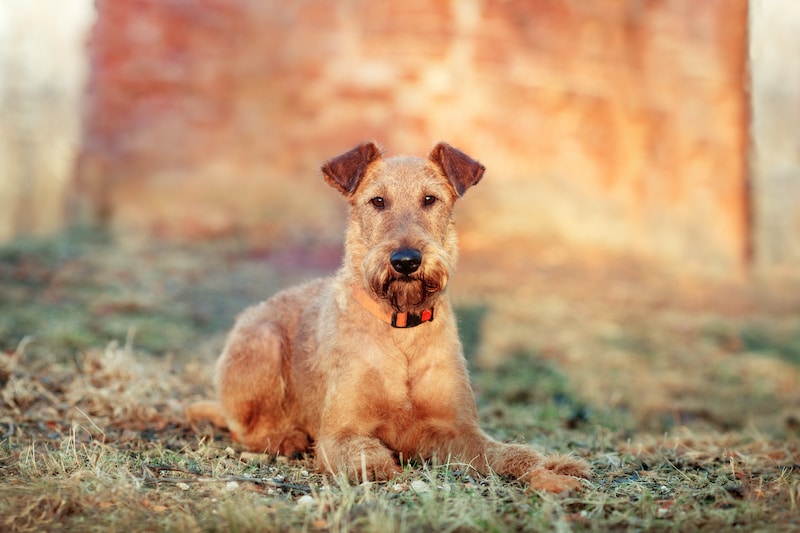Irish Terriers are medium-sized, all-purpose farm dogs that originate from Ireland. They are easily recognized by their red coat and bold, courageous (yet gentle) nature.
They don’t shed much either!
Irish Terriers have short, dense, wiry coats that shed very little. Although they their coat does require regular brushing and either hand stripping or trimming to keep it in good shape.
Read on to learn more about the ITs coat, how much they shed and what they’re like to groom, so you know what to expect if you do decide to adopt.
Recommended: Go here to see our top-rated dog hair blow dryers
The Irish Terrier Coat
Irish Terriers have a double coat, which means they have both an outer coat of hair and an undercoat.
The outer coat consists of short, wiry, dense and overall harsh guard hairs that are notably red in color. Although they can be red wheaten or wheaten.
The undercoat, however, is softer and finer and this is what helps to keep him warmer in winter and cooler during summer. It’s basically a natural insulator.
The good news about this type of coat is that it doesn’t shed very much, the downside is that, as with all wire-coated dogs, they’re not the easiest to groom.
Let’s explore each of these aspects in more detail.
Shedding Guide
Irish Terriers are a low shedding breed.
They’re not quite as low shedding as an Irish Water Spaniel, but they tend to shed less than other Irish breeds like the Irish Wolfhound and Irish Setter for example.
If I had to compare them to another terrier in terms of how much they molt, I’d say they shed about the same as the Airedale Terrier. And as with the Airedale Terrier, Irish Terriers are often described as being “hypoallergenic,” meaning they’re more suitable for people who suffer from pet-related allergies.
That doesn’t mean they’re completely non-allergenic though.
Because, like all dogs, the coat of an IT produces dander, which is basically another word for “dead skin flakes,” and this is what causes allergies to dogs in the first place. Also, the American Kennel Club does NOT list Irish Terriers as hypoallergenic, so it pays to be cautious of anyone claiming otherwise.
Related: Dog Shedding FAQ (What is a Hypoallergenic Dog?)
In any case, they are a low shedder with a coat that is (generally) better for those who are concerned about allergies. That doesn’t mean you won’t notice any hair around the home, but it typically won’t be much and nothing you can’t manage with proper diet and grooming.
Making sure your ITs diet is optimal not only helps him to live a healthier, happier life but can also help improve his coat. And a healthier coat leads to stronger hairs that don’t fall out as often. So it’s worth speaking with your vet about selecting the most optimal food for your dog as this can make a huge difference overall.
Just as important is grooming, so let’s dig into that.
Grooming Your IT
Grooming your IT isn’t difficult, certainly not compared with some breeds, but it does take more work than the average dog to maintain their coat.
And the reason for this has to do with their wiry coats.
As with any wire-coated breed, they either need to be hand stripped a couple times per year, or trimmed on a regular basis. As well as brushed regularly to remove any mats or tangles they may have accumulated. Since these can become quite painful if left unchecked.
Hand stripping is the best option for show dogs or if you’re fussy about how his coat looks. Because it basically helps to maintain the color and texture of the coat better than what clipping does.
However, it’s not easy to do and can be very time consuming, because it literally involves either plucking the old hairs out by hand or removing them with a stripping knife.
As you can imagine, this is a tedious process that is best done by a professional groomer! And not many groomers can do this either, so it’s not going to be cheap. The good news is though, you only need to have this done a couple times each year if you do decide to go this route.
Here’s a helpful video I found about hand stripping your IT:
The other method is either trimming or clipping.
This doesn’t mean shaving them down to the skin, ITs need their undercoat so removing this is not a good idea. What it means is simply trimming or clipping the hair down to a reasonable length to ensure that it doesn’t grow out of control.
The plus side is this is easier and less expensive to have done. The downside is you’ll need to have it done more often and it’s not the optimal way to keep the color and texture of his coat. Which is one of the defining features of these red “daredevils.”
Here’s a video showing you how to clip your Irish Terrier:
Either way, he will need to be brushed on a weekly basis with a slicker brush or metal comb to keep the coat tangle-free and remove the dead hairs. As mentioned, ITs don’t shed much, but like all dogs they do molt. And brushing is one of the best ways to get a handle on it.
No pun intended!
Aside from brushing, the occasional bath can be beneficial.
Especially during shedding season, which tends to come about during spring and fall. They normally don’t need to be bathed very often, but bathing him with a good quality dog shampoo that doesn’t dry out his coat can be worthwhile, as long as you don’t overdo it.
Bottom Line
Irish Terriers are fiery, courageous working dogs as well as gentle family companions. And to top it off, they shed very little. So as long as you don’t mind a bit of extra grooming, chances are you’ll love adopting an IT and welcoming him into your home.
That said, while there is no substitute for an Irish Terrier, if you’re looking for a lower maintenance dog there are some more suitable options to consider. Such as the Beagle, Toy Fox Terrier or Miniature Pinscher for example.













Please note: By submitting a comment using the above comment form, you confirm that you agree with the storage and handling of your data by this site as detailed in our Privacy Policy.